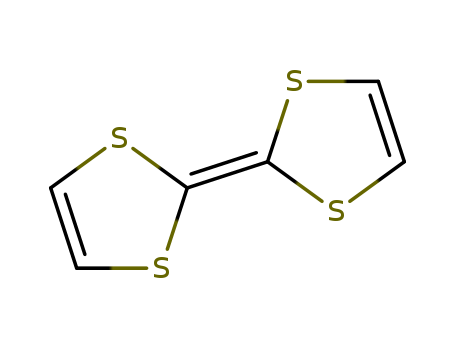10.1039/c0jm02293d
The research focuses on the synthesis and characterization of a new hybrid tetrathiafulvalene (TTF)-oligothiophene compound featuring a TTF core fused between two hepthiophene chains. A range of experiments were performed on the compound, including cyclic voltammetry, UV-visible spectroelectrochemistry, X-ray crystallography, and time-of-flight measurements, to investigate its electronic, redox, and charge transport properties. The experiments used various reactants during the synthesis, such as 2-bromo-3-hexyl-5-methylthiophene, 2-thienylzinc bromide, and n-BuLi/DMF, and involved measurements such as hole mobility and electrochemical HOMO-LUMO gap. The purpose of the analysis was to compare the properties of the hybrid compound (1) with those of a half-unit (9) lacking the TTF core, with the aim of understanding the impact of the TTF fusion on the material properties, which is crucial for the development of polymer-based semiconductor devices.
10.1002/chem.201101266
The study presents the design, synthesis, and characterization of a tetrathiafulvalene-calix[4]pyrrole receptor, which can be controlled by external acid/base inputs to regulate its molecular recognition of guest molecules. The receptor, named ouroboros due to its self-complexation property, is composed of three identical tetrathiafulvalene (TTF) units and a fourth TTF unit appended with a phenol moiety. The phenol group allows for the receptor to switch between a locked (ouroboros) and unlocked state through deprotonation/protonation, thereby controlling the binding and release of guest molecules like 1,3,5-trinitrobenzene (TNB). The chemicals used in the study include tetrathiafulvalene derivatives, phenol, and various reagents for synthesis such as CsOH·H2O, 4-(3-bromopropyl)phenol, NaOMe, and tetrabutylammonium chloride (TBACl). These chemicals served the purpose of constructing and modifying the receptor molecule, as well as studying its interactions with TNB guests through absorption and 1H NMR spectroscopy, which revealed the receptor's ability to switch conformations and control guest binding based on pH changes.
10.1021/ja00247a049
The study focuses on the synthesis and characterization of tetramethyltetratellurafulvalene (TMTTeF) and its electrochemical properties. TMTTeF was synthesized using a method involving acetylene, hexamethylditin, n-BuLi, and elemental tellurium, with tetrachloroethylene as a reactant in the final step. The compound was purified through chromatography and characterized by spectroscopic methods, including mass spectrometry and NMR spectroscopy. The electrochemical data, obtained by cyclic voltammetry, revealed that TTeF exhibits two reversible one-electron oxidations, with an ionization potential between that of tetrathiafulvalene (TTF) and tetraselenafulvalene (TSF). The study also discusses the presence of a six-membered ring isomer in the crude TTeF, identified through an irreversible oxidation peak in the cyclic voltammogram. The research aims to explore the potential of TTeF in forming organic metals and to make this synthesis available to the broader scientific community for further exploration of its solid-state properties.
10.1039/c39930000689
This research focuses on the development of new n-electron donors by combining the tetrathiafulvalene (TTF) system with conjugated backbones of substituted terthienyls to improve control of charge transport and superconducting properties of the corresponding cation radical salts (CRSs). The study aims to increase material dimensionality by modifying the spatial extension of the n-donor and intermolecular interstack bonding. The researchers synthesized extended π-electron donors of the TTF series containing substituted terthienyl spacers using a five-step synthetic route. Key chemicals used include 3-octyl and 3-(3,6-dioxaheptyl)thiophene, bromine, 2-thienylmagnesium bromide, N-methylformanilide, acetic anhydride, and phosphonic acid. The study found that substitution of the conjugated spacer significantly affects the solubility, electronic absorption spectrum, and electrochemical behavior of the donor molecules. For example, the introduction of methyl groups increases solubility, while longer alkyl or oxyalkyl substituents cause red shifts in the absorption spectrum. The terthienyl spacer also leads to a marked decrease in oxidation potentials and a reduction in on-site coulombic repulsion between positive charges in the dication state. The research concludes that these new structures can be considered as first examples of oligothiophenes derivatized by a TTF system, and further work is needed to clarify the mechanisms behind the observed spectral changes and to explore the electrical properties of the conducting adducts obtained by iodine doping.
10.2478/s11532-011-0104-9
The research focuses on the synthesis and characterization of a novel redox-active calix[4]arene-tetrathiafulvalene (TTF) dyad, which integrates the host properties of calix[4]arene with the redox characteristics of TTF. The experiments involved the preparation of the dyad through a series of chemical reactions, utilizing reactants such as p-tert-butylcalix[4]arene, tosylated TTF, and cesium fluoride. The structure of the synthesized dyad was confirmed using X-ray diffraction analysis, and its electrochemical properties were investigated by cyclic voltammetry, revealing two reversible one-electron redox waves. Additionally, UV-vis absorption spectra studies were conducted to assess the dyad's recognition properties for metal ions, particularly its interaction with Cu2+ and Hg2+, which led to the progressive oxidation of the TTF unit. Various analytical techniques were employed, including NMR, IR, and mass spectrometry, to characterize the synthesized compounds and intermediates.
10.1002/jhet.5570420515
The study focuses on the synthesis, structure, and electrochemical properties of two new unsymmetrical tetrathiafulvalene (TTF) derivatives, 2,3-bis(cyanoethylthio)-6,7-(methylethylenedithio)tetrathiafulvalene (6a) and 2,3-bis(cyanoethylthio)-6,7-(cyclopentodithio)tetrathiafulvalene (6b). These compounds were synthesized using a method involving the coupling of 1,3-dithiole-2-thione and 1,3-dithiole-2-one in the presence of phosphite. The synthesis started from (Et4N)2[Zn(dmit)2] and involved several steps, including alkylation and reactions with various reagents such as oligo(4,5-dihydro-1,3-dithiole-2,4,5-trithione) and cyclopentene. The molecular structures of 6a and 6b were determined by X-ray crystallography, revealing differences in the orientation of the cyanoethyl groups and packing modes. The redox properties of these compounds were investigated by cyclic voltammetry, showing two reversible single-electron redox couples for each, with close redox potentials indicating similar electron effects on the TTF core. The study highlights the potential of these unsymmetrical TTF derivatives for applications in organic conductors and superconductors.





